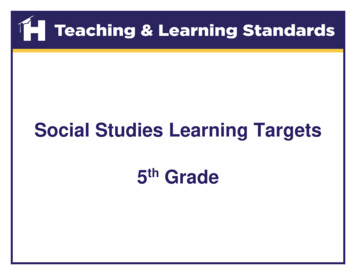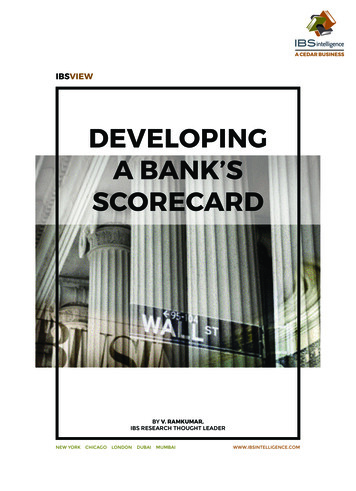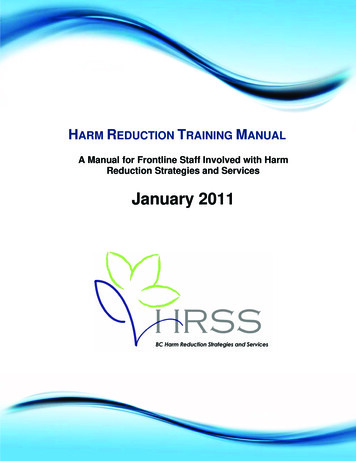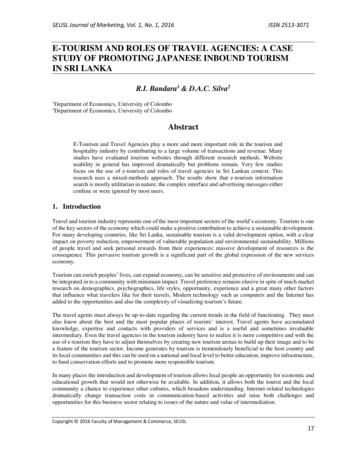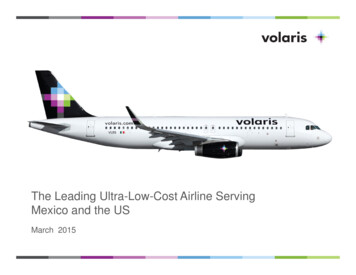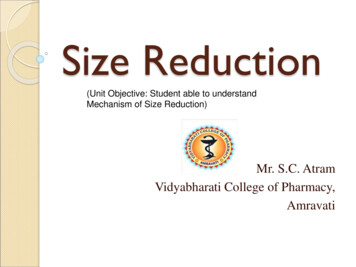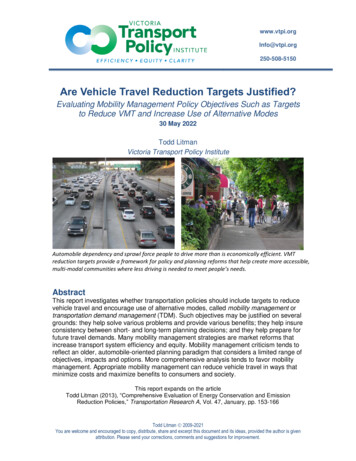
Transcription
www.vtpi.orgInfo@vtpi.org250-508-5150Are Vehicle Travel Reduction Targets Justified?Evaluating Mobility Management Policy Objectives Such as Targetsto Reduce VMT and Increase Use of Alternative Modes30 May 2022Todd LitmanVictoria Transport Policy InstituteAutomobile dependency and sprawl force people to drive more than is economically efficient. VMTreduction targets provide a framework for policy and planning reforms that help create more accessible,multi-modal communities where less driving is needed to meet people’s needs.AbstractThis report investigates whether transportation policies should include targets to reducevehicle travel and encourage use of alternative modes, called mobility management ortransportation demand management (TDM). Such objectives may be justified on severalgrounds: they help solve various problems and provide various benefits; they help insureconsistency between short- and long-term planning decisions; and they help prepare forfuture travel demands. Many mobility management strategies are market reforms thatincrease transport system efficiency and equity. Mobility management criticism tends toreflect an older, automobile-oriented planning paradigm that considers a limited range ofobjectives, impacts and options. More comprehensive analysis tends to favor mobilitymanagement. Appropriate mobility management can reduce vehicle travel in ways thatminimize costs and maximize benefits to consumers and society.This report expands on the articleTodd Litman (2013), “Comprehensive Evaluation of Energy Conservation and EmissionReduction Policies,” Transportation Research A, Vol. 47, January, pp. 153-166Todd Litman 2009-2021You are welcome and encouraged to copy, distribute, share and excerpt this document and its ideas, provided the author is givenattribution. Please send your corrections, comments and suggestions for improvement.
Are VMT Reductions Targets Justified?Victoria Transport Policy InstituteIntroductionMany jurisdictions have targets to reduce vehicle travel and increase use of non-auto modes(walking, bicycling, public transit, etc.) to achieve various economic, social and environmentalgoals. For example, California state law requires that per capita vehicle travel be reduced 15%by 2050 (GOPR 2018). Washington State requires 30% reductions by 2035 and 50% by 2050(WSL 2008). New Zealand’s target is to reduce light-duty vehicle travel 20% by 2035 (NZMoE2022). British Columbia’s target is to reduce light-duty vehicle travel 25% between by 2030 andapproximately double walking, bicycling and public transit half of all trips by 2050 (CleanBC2021). Colorado state law requires that all major transportation projects support emissionreduction targets (Degood and Zonta 2022). Israel’s goal is to cut car travel in half (Zagrizak2022). Minnesota’s goal is to reduce vehicle travel 20% by 2050 (Bellis 2021). The UnitedKingdom’s goal is that half of all urban journeys will be by active modes by 2030 (DfT 2020).Scotland has a target to reduce vehicle travel by 20% by 2030 (Reid 2020). Many cities also haveVMT reduction targets. Guides and tools are available for designing and evaluating VMTreduction plans (Byars, Wei and Handy 2017; Caltrans 2020; TransForm 2009).Examples of Local VMT Reduction Targets (ACEEE 2019; Klein 2020; PBOT 2021; Thorwaldson 2020 Zagrizak 2022) Boston: put every home within 10 minutes of public transport, bike share, and car share by 2050. Columbus: Create “smart mobility hubs,” to help residents travel without a car. Minneapolis: reduce VMT 40% by 2040 through walking, bicycling, public transit and compact development. Orlando: most local trips are done on foot, bike, carpooling, or transit. Phoenix: by 2050, 90% of residents live within a half-mile of transit, and 40% commute by non-auto modes. Portland: reduce vehicle travel and associated emissions by 45%. San Antonio: reduce average daily vehicle-miles per capita from 24 now to 19 by 2040.Some critics argue that such targets are misguided. Highway advocacy groups (HUA 2009),activist organizations (Poole 2009; O’Toole 2009; Cox 2009), and some transport policy experts(Pisarski 2009a) argue that VMT reduction policies are costly, unfair, and harmful to consumersand the economy. Some environmental advocates argue that “clean vehicle” strategies, such asshifting to hybrid and electric vehicles, are more effective at reducing emissions than VMTreductions (Hawken 2017). Poole (2009a) calls VMT reduction goals “a terrible idea” andchallenges proponents to prove they are cost effective. I accept that challenge.VMT reduction policies are not necessarily the most effective way of achieving any single goalbut are often cost effective considering all impacts (benefits and costs). They can: Help achieve multiple community goals including congestion reduction, facility cost savings,consumer savings, investment fairness between drivers and non-drivers, public health, trafficsafety, improved mobility for non-drivers, energy conservation and emissions reductions. Align policies between different levels of government and organizations, for example, toensure consistency between local, state and federal policies. Respond to changing travel demands and community priorities (ITF 2021a).This report investigates these issues. It discusses justifications for VMT reduction targets andevaluates criticisms of these policies. It discusses how mobility management objectives can helpcreate a transport system that better responds to future needs.1
Are VMT Reductions Targets Justified?Victoria Transport Policy InstituteAccessibility versus MobilityTo understand this issue it is useful to consider the distinction between accessibility (people’sability to reach desired goods, services and activities) and mobility (physical movement).Accessibility is the ultimate goal of most transportation activity, excepting the small portion oftravel for which movement is an end in itself such as jogging or cruising; even recreational travelusually has a destination such as a picnic site or resort (Litman 2003; Sundquist, McCahill andBrenneis 2021). The key question in this analysis is whether it is possible to achieve accessibilitywith less mobility.Planning decisions often involve tradeoffs between different types of access accessibility. Forexample, wider roads and increased traffic volumes and speeds reduce pedestrian access, andtherefore public transit access since most transit trips involve walking links; automobile-orientedland use patterns (dispersed, urban fringe development with abundant parking) tends to bedifficult to access by walking, cycling and public transit); and resources devoted to automobiletransport are unavailable for alternative modes.VMT reduction critics tend to assume that transportation means automobile travel, so anyreduction in vehicle travel reduces accessibility. VMT reduction advocates tend to consider abroader range of accessibility factors, so VMT reductions need not reduce accessibility ifimplemented with improvements to alternative modes and more accessible land usedevelopment. They argue that appropriate VMT reduction strategies can improve overallaccessibility, transport system efficiency, and user benefits.VMT reduction advocates argue that current planning practices are distorted in various waysthat favor automobile dependency, and therefore result in economically excessive vehicle travel,that is, vehicle travel for which total costs exceed total benefits (Boarnet 2013; Garceau, et al.2013; Levine 2006). For example, automobile travel is significantly underpriced (road, parking,insurance and fuel prices do not reflect marginal costs); a major portion of transport funding isdedicated to roads and parking facilities and cannot be used for other modes or mobilitymanagement strategies even if they are more cost effective overall; and many land use planningpractices discourage compact, mixed, infill development (Litman 2014a). Correcting thesedistortions tends to reduce automobile travel in ways that increase economic efficient andbenefits consumers overall (Clarke and Prentice 2009).California state law, SB 743 (2013), requires that transportation project environmental impactsbe evaluated based on their vehicle miles travelled (VMT) rather than roadway level of service(LOS), which is sometimes called a shift from LOS to VMT (Lee and Handy 2018). GovernorExecutive Order (EO) N-19-19 (2019) requires state agencies to reduce greenhouse gasemissions. The California State Transportation Agency (CalSTA 2021) and the Northern CaliforniaInstitute of Transportation Engineers (ITE SB 743 Task Force 2021) have developed guidelines forapplying these policies to transportation planning decisions. These policies support a shift frommobility-based to accessibility-based planning, which recognizes that improvements to non-automodes and more accessible land use development policies can increase accessibility whilereducing mobility. For example, these policies recognize the important roles that walking,bicycling and public transit play in an efficient and equitable transportation system; reformtransportation funding favor efficient modes; and favor infill development over urban expansion.2
Are VMT Reductions Targets Justified?Victoria Transport Policy Institute3
Are VMT Reductions Targets Justified?Victoria Transport Policy InstituteHow Much Vehicle Travel Do People Need?Per capita vehicle travel varies significantly among U.S. urban regions, as illustrated below.Average Daily VMT Per CapitaFigure 1Per Capita Vehicle Travel in Selected Urban Regions (FHWA 2018)50403020100Per capita daily vehicle-miles range from less than 16 to more than 50 among U.S. urban regions.There are similar ranges within an urban region. Daily VMT are about three times higher insuburban locations than in compact, multimodal neighborhoods, as illustrated below.Household VMT by Neighborhood Type (Salon 2014)Daily Vehicle-Miles60105084063042021000Central CityTransitOrientedSuburb,MultifamilyUrban, LowTransit UseRuralPer capita average daily vehicle-miles vary significantly within urban regions.4Suburb,Single-FamilyAnnual Tons of C02Figure 2
Are VMT Reductions Targets Justified?Victoria Transport Policy InstituteFigure 3Household Climate Emissions, Nashville, TN (Cool Climate Maps)Cool Climate Maps showaverage climateemissions fromtransportation, housingand goods consumptionby geographic location.This example shows themuch lower emissionstypical of centralneighborhoodscompared withautomobile-dependent,sprawled areas, duelargely to lower vehicletravel.NashvilleThese studies indicate that vehicle travel is highly variable, depending on geographic andeconomic factors. There is no evidence that residents of high vehicle-miles communities accessmore activities or are more productive than lower vehicle-miles communities. In fact, lowervehicle-miles communities tend to have more economic productivity and residents spend lesstotal time travelling than in higher vehicle-miles areas, as described later in this report. In otherwords, you can say that automobile-dependent areas provide less efficient access: residentsmust travel further to reach desired services and activities. This is not to say that automobiledependency is bad, but it is costly in terms of time and travel expenses.Figure 4Optimal Automobile Mode Shares (Litman 2014b)Optimal Automobile Mode ined50%40%30%20%10%0%Rural/SuburbanUrban NeighborhoodDowntown5The optimal level of automobiletravel declines with density andpoverty. In affluent, sprawledsuburbs, most trips can be byautomobile, but this should declineas densities or poverty increases,and should be less than 30% inmost urban neighborhoods. Variousdemand management strategiescan be used to favour more spaceefficient and affordable modes overprivate automobiles.
Are VMT Reductions Targets Justified?Victoria Transport Policy InstituteThe key issue for this discussion is whether, given better transportation options and incentives,transportation systems could become more efficient, so people can meet their accessibilityneeds with fewer vehicle-miles. To justify high rates of automobile travel, VMT reduction criticssometimes describe a type of trip that is best made by automobile. “You can’t move furniture bybicycle,” or “It would take me three times longer to commute by public transit than by car.” Thismay be true, but does not prove that vehicle travel reductions are infeasible. The fact that sometrips are best made by automobile does not mean that all trips should be made by automobile,or that current levels of vehicle travel are optimal.Evidence discussed later in this report indicates that, given better options and incentives, amajor portion of vehicle travel could be reduced in ways that are cost-effective overall. The keyis to focus on the most changeable trips. Some people assume that there are few ways toreduce mileage, for example, arguing that vehicle travel reductions are only achievable in largecities with high quality public transit, and are therefore infeasible in rural area. However,motorists actually have many ways to reduce mileage, by choosing closer destinations,consolidating trips, shifting modes, and using mobility substitutes (telecommunications anddelivery services). Since rural residents currently drive relatively high annual miles, they areoften able to achieve relatively large mileage reductions. New technologies can significantimprove non-auto accessibility. For example, the COVID pandemic demonstrated thattelecommunications and delivery services can substitute for many vehicle trips, studies suggestthat e-bikes could substitute for 10-30% of local trips, and integrated navigation and paymentapps can make ridesharing, and public transit services more convenient for many trips.There are two related challenges to vehicle travel reductions. First, although automobiles areexpensive to own, their variable costs are low, typically costing just 10-15 per vehicle-mile.After spending thousands of dollars a year in fixed expenses, vehicles, owners often feel thatthey should maximize their mileage in order to get their money’s worth from their largeinvestments. In addition, for many people driving is more prestigious than other modes; theyfeel embarrassed walking, bicycling or using public transit. As a result, motorists often driveeven when they have good alternatives, such as to local destinations within convenient walkingand bicycling distance, and on urban corridors with frequent public transit services.The second challenge is that mobility options have strong economies of scale. If most people ina community rely on automobiles, other modes are likely to be inefficient and stigmatized. Formost of the last century, most communities have experienced a self-reinforcing cycle ofautomobile-oriented transportation planning and sprawled development patterns which createautomobile-dependent communities.6
Are VMT Reductions Targets Justified?Victoria Transport Policy InstituteMobility Management DefinedMobility management (also called transportation demand management [TDM] and VMTreduction strategies) refers to policies and programs that change travel activity to increasetransport system efficiency (VTPI 2008; ICAT 2020; TfA and SGA 2020). Table 1 lists commonmobility management strategies.Table 1Mobility Management Strategies (ICAT 2020; ITF 2021; VTPI 2008)Improved OptionsIncentivesLand Use PoliciesTransit improvementsCongestion pricingSmart growthWalking and cyclingimprovementsDistance-based feesNew urbanismParking cash outParking managementRideshare programsParking pricingVMT developer feesFlextimeTeleworkPay-as-you-drivevehicle insuranceTransit orienteddevelopmentCarsharingFuel tax increasesCar-free planningProgramsCommute trip reductionprogramsSchool and campustransport managementFreight transportmanagementTDM marketingThis table lists various mobility management strategies.Mobility management is more than individual solutions to individual problems, such as roadpricing to reduce congestion and transit improvements to reduce pollution; it is most effective ifimplemented as an integrated program that includes improved transport options and incentivesto use the most efficient option for each trip. It is supported by professional organizations suchas the Institute of Transportation Engineers and the Federal Highway Administration. Evenroadway expansion advocates often support some mobility management strategies such asefficient road and parking pricing (Staley and Moore 2008). It reflects a paradigm shift, assummarized in Table 2.Table 2Transport Planning Paradigm Shift (Litman and Burwell 2006)FactorOld ParadigmNew ParadigmDefinition of transportationVehicle travel – mobilityAccessibility (ability to reach desiredgoods, services and activities)Modes consideredAutomobile and truckAll modes (walking, cycling, publictransit, automobile, telework, etc.)Land use developmentLow-density, automobiledependentCompact, mixed, multi-modalPerformance indicatorsVehicle traffic speeds, roadwayLevel-of-ServiceMulti-modal Level-of-Service, overallaccessibilityFavored improvementsExpanded road and parkingcapacity, increased traffic speedsMulti-modal improvements, mobilitymanagement,A paradigm shift is changing the way transportation problems are defined and solutions evaluated.Disagreements about the merit of mobility management often reflect differences in analysisscope – the range of benefits and costs considered. Critics generally consider just one or twobenefits, while proponents consider more, including some often overlooked in conventional7
Are VMT Reductions Targets Justified?Victoria Transport Policy Institutetransport project evaluation such as parking cost savings, vehicle ownership cost savings, andhealth impacts. For example, Poole (2009) and Pisarski (2009a) criticize VMT reduction policiesas an inefficient way to reduce pollution emissions; such criticism would be justified if pollutionreduction was the only benefit these policies provide, but when other impacts are consideredmobility management is often cost effective overall.Critics often assume that everybody (at least, everybody who matters) drives, and so ignore thebenefits of improving mobility for non-drivers. They tend to assume that past vehicle travelgrowth rates will continue into the future. They ignore current demographic and economictrends (aging population, rising fuel prices, increased urbanization, increasing traffic congestion,and increased health and environmental concerns) which are reducing VMT growth andincreasing the value of alternative modes (NAR 2020).Figure 5U.S. Average Annual Vehicles Mileage (FHWA, Various Years)Annual Vehicle-Miles Per 9401950196019701980199020002010Per capita motor vehicle travel increased during the Twentieth Century but peaked about 2000.Many current demographic, economic and technical trends are reducing vehicle travel demand.Mobility management critics often ignore rebound effects (also called takeback or induced traveleffects) the additional vehicle travel that results from roadway expansion and increased vehiclefuel economy (Moshiri and Aliyev 2017). Ignoring these effects exaggerates the value of highwayexpansion and fuel efficiency standards and so undervalues mobility management solutions.Critics often argue that mobility is very inelastic, citing research Small and Van Dender (2007)which implies that even large price increases have little effect on vehicle travel. But that studywas based on U.S. data from 1960 to 2000, a unique period of rising vehicle ownership,increasing employment and real incomes, declining real fuel prices, highway expansion,declining transit service quality, and suburbanization. More recent analysis indicates thatmotorists are becoming more price sensitive (Brand 2009; Litman 2010).8
Are VMT Reductions Targets Justified?Victoria Transport Policy InstituteMobility Management JustificationsThis section discusses justifications for mobility management and therefore VMT reduction targets.Helps Solve Multiple Problems and Provide Multiple BenefitsThe old planning paradigm was reductionist: each problem was assigned to a profession oragency with narrowly defined responsibilities: transportation agencies were responsible forreducing traffic congestion, health agencies for improving public fitness and health, andenvironmental agencies for reducing pollution. This can result in those organizations rationallyimplementing solutions that contradict other community goals, and tends to undervaluesolutions that provide multiple benefits. The new paradigm is more comprehensive, and sosearches for win-win solutions that help achieve multiple community goals, such as congestionreduction strategies that also increase public fitness and reduce pollution.Mobility management tends to provide many benefits (VTPI 2008). Although a particularmobility management strategy may not be the most cost effective solution to a single problem,it is often the most beneficial strategy overall, considering all impacts. For example, consideringjust short-term congestion impacts, highway widenings often seem justified, and consideringjust emission reductions, alternative fuel vehicle subsidies often seem justified, but thosestrategies provide a limited range of benefits, and tend to induce additional vehicle travel, whichreduces their intended benefits and increases other problems. By reducing congestion delays,urban roadway expansions tend to induce additional vehicle travel, which over the long runincreases downstream congestion, crashes and pollution emissions. Similarly, by reducing fuelcosts, efficient and alternative fueled vehicles tend to increases total vehicle travel andtherefore congestion, infrastructure costs, crashes and sprawl-related costs. Mobilitymanagement strategies tend to achieve many planning objectives, as illustrated in Table 3.Table 3Comparing Strategies (Litman 2011)PlanningObjectiveMotor Vehicle TravelUser convenience and comfortCongestion reductionRoad and parking cost savingsConsumer savingsReduced traffic accidentsImproved mobility optionsEnergy conservationPollution reductionPhysical fitness & healthEconomic developmentLand use objectivesRoadwayExpansionFuel sedReduced / ? ? ( Achieve objectives. Contradicts objective.) Roadway expansion and more fuel efficientvehicles provide a limited range of benefits, and by increasing total vehicle travel they can exacerbateother problems such as congestion, accidents and sprawl. Win-Win Solutions tend to reduce totalvehicle travel and increases economic efficiency, which helps achieve many planning objectives.9
Are VMT Reductions Targets Justified?Victoria Transport Policy InstituteIncreases Efficiency and FairnessMobility management includes various reforms that increase economic efficiency and equity. Anefficient transport system should reflect these principles: Consumer options. Consumers have a variety of transport and location options so theycan choose the combination that best meets their needs and preferences. Efficient pricing. The prices that consumers pay for a good reflect the full marginal costsof supplying that good, unless a subsidy is specifically justified. Economic neutrality. Public policies and planning practices are not arbitrarily biased infavor of one good over others.Current policies and planning practices are distorted in various ways that tend to increase motorvehicle travel beyond what is economically optimal, as summarized in Table 4.Table 4Transport Planning Distortions (Clarke and Prentice 2009; Litman 2006)DescriptionExamplesPoor walking and rs often havelimited alternatives toautomobile transportationand automobile-orientedlocation.Inadequate public transitservice.Lack of housing in accessible,multi-modal locations.Unpriced roads.Unpriced parking.EfficientPricingMany motor vehicle costs arefixed or external.TransportPlanningPracticesTransportation planning andinvestment practices favorautomobile-orientedimprovements, even whenother solutions are more costeffective.Fixed insurance andregistration fees.Low fuel prices.Dedicated roadway funding.Transportation systemperformance indicators basedon vehicle traffic conditions.Incomplete impact analysis.Potential ReformsImprove alternative modessuch as walking, bicycling,public transit and carsharing.Integrate alternative modes.More affordable housing inaccessible locations.As much as feasible, chargemarginal prices for roads,parking and emissions, andconvert fixed costs, such asinsurance and registrationfees, into variable costs.Apply least-cost planning.Fund alternative modes andmobility managementwhenever cost effective.Apply multi-modal transportperformance indicators.Parking minimums.Land UsePolicesCurrent land use planningpolicies encourage lowerdensity, automobile-orienteddevelopment.Restrictions on developmentdensity and mix.Development and utility feesthat fail to reflect the highercosts of dispersed locations.Smart growth policy reformsthat support more accessible,multi-modal land usedevelopment. Location-baseddevelopment and utility fees.This table summarizes various transportation market distortions and potential reforms.10
Are VMT Reductions Targets Justified?Victoria Transport Policy InstituteThese distortions help create a self-reinforcing cycle of increased automobile dependency andsprawl (Figure 6). Mobility management tends to correct these distortions, leading to morebalanced and efficient transport systems.Figure 6Cycle of Automobile Dependency and SprawlThis figure illustrates the selfreinforcing cycle of increasedautomobile dependency andsprawl. Establishingobjectives to reduce vehicletravel and increase use ofalternative modes can helpcorrect existing marketdistortions that lead toinadequate transport options,economically excessiveautomobile travel, andsprawled land use patterns.Various policy and planning reforms are justified on economic efficiency and planning principles,such as more efficient road, parking, insurance and fuel pricing; more comprehensive andintegrated planning; least-cost funding and neutral tax policies. Transportation professionalscategorize these reforms as mobility management strategies.Critics might argue that VMT reductions should be an outcome of market reforms rather thanplanning objectives. They could suggest, “Let’s just implement efficient pricing and letconsumers decide how much to reduce their mobility.” But the first step in reforming outdatedpolicies is to establish new goals and performance targets. VMT reduction targets are often thebest way to begin implementation of economically-justified policy and planning reforms; theyfocus political and institutional actions toward reform. For example, VMT reduction targetsencourage legislative changes to support efficient road and parking pricing, and fortransportation agencies to apply least-cost investments and develop more multi-modal planningpractices. Similarly, these targets encourage local governments to reform zoning codes andimplement more efficient parking management.Least-Cost Planning (Lindquist and Wendt 2012)Least-cost planning is a planning framework that implements the most cost-effective solution toa problem, considering all impacts (costs and benefits), giving equal consideration to demandmanagement as capacity expansion. This tends to justify far more implementation of mobilitymanagement solutions than what occurs under current planning practices which consider alimited set of planning goals and have dedicated funds for facility improvements that cannot beused to implement mobility management strategies.11
Are VMT Reductions Targets Justified?Victoria Transport Policy InstituteProvides Strategic Guidance for Individual Policy and Planning DecisionsA fundamental principle of good planning is that individual, short-term decisions should beconsistent with strategic, long-term goals. Current transportation policies often fail to reflectthis principle: individual planning decisions often contradict strategic objectives, resulting ininefficiency. Mobility management objectives can help guide individual policy and planningdecisions so they are more integrated. For example, mobility management objectives encouragepolicy makers to choose efficient pricing and investments, transportation agencies to developmobility management programs, and transportation professionals to learn about mobilitymanagement techniques.Many policy and planning decisions affect the amount of mobility that occurs in an area, assummarized in Table 5. Although individually decisions that stimulate automobile travel mayseem modest and justified, their impacts are cumulative and synergistic. People who live orwork in automobile-oriented areas typically drive 40-60% more annual miles and rely less onalternative modes than they would in more multi-modal communities (Pratt 1999-2009; Ewing,et al. 2007; VTPI 2008; TransForm 2009).Table 5Examples of Policy and Planning Decisions That Affect MobilityTransport PoliciesFuel taxes and pricesRoad tollsRoadway supply and designSidewalk and path supply and qualityPublic transit service supply and qualityMobility management programsLand Use PoliciesLocation of facilities and activities (jobs, housing,services, etc.)Land use density and mixParking supply and priceBuilding orientationMany policy and planning decisions affect the amount and type of mobility that occurs in an area.Conventional planning often ignores these long-term impacts. Many transport and land usepolicy decisions are based on narrow, short-term objectives with little consideration of strategicgoals. For example, transportation agencies often expand roadways to re
Are VMT Reductions Targets Justified? Victoria Transport Policy Institute 2 Accessibility versus Mobility To understand this issue it is useful to consider the distinction between accessibility (people's ability to reach desired goods, services and activities) and mobility (physical movement). Accessibility is the ultimate goal of most transportation activity, excepting the small portion of
